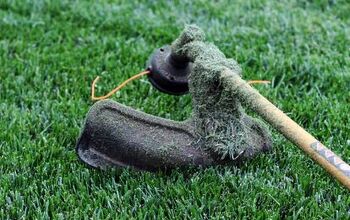Power Washer Won't Start? (Possible Causes & Fixes)

A pressure washer is a highly versatile tool that no homeowner should be without. The things that it can help you do are far-reaching and it will quickly become a favorite tool around the house. Unfortunately, things can and will go wrong from time to time.
When your pressure washer won’t start, there are a number of components that can be at fault. The carburetor, spark plug, ignition coil, and the flywheel key are all the most likely causes for the failure to start. Troubleshooting the issue is the main way that you can determine the cause of the issue behind the start malfunction.
Do You Need Powerwashing Services?
Get free, zero-commitment quotes from pro contractors near you.

Carburetor
Like any combustion engine, the carburetor is essential to the starting process. When the carburetor is at fault, the most likely issue is due to a clog somewhere within. And 9 times out of 10, the reason for the clog is due to fuel that has been left in your pressure washer for long periods.
Some of the ingredients within the fuel can evaporate over time. When this happens, there is a sticky, thick residue that gets left behind. That stickier fuel can eventually clog the carburetor, preventing the engine from starting altogether.
Fixing the Carburetor
Thankfully, there are carburetor cleaners out there specifically designed to handle this sort of issue. Start by cleaning the carburetor thoroughly to ensure that the sticky fuel is completely removed. If that doesn’t solve the issue, you may have to either rebuild the carburetor or replace it entirely.
Spark Plug
If the carburetor is not at fault, the other most likely issue will be the spark plug. Start by inspecting the spark plug for excessive wear and tear or any signs of damage. There are also a few telltale signs that the spark plug needs replacing: an electrode has become damaged or burned away, the porcelain insulator has a crack, or you notice heavy carbon buildup at the electrode.
Should the spark plug look fine, you can test to see if it’s defective. Using a spark plug tester, check to see if there is a strong spark emanating from between the terminals of the tester while the engine is cranking. No spark means that your spark plug is defective and is to be replaced entirely.
Ignition Coil
The role of the ignition coil is to send the proper voltage to the spark plug as the engine runs. When the ignition coil is ineffective or defective, it could be the reason that the power washer’s engine won’t start at all.
Don’t go right to replacing the ignition coil, though. Check the spark plug first as that is typically the reason that the engine won’t start. Should you confirm that the spark plug is fine and working properly, you can use an ignition coil tester to check that component. If it isn’t working properly or at all, replace it and try starting the power washer again.
Flywheel Key
This small, metal piece fits into the crankshaft of the power washer and ultimately engages the flywheel. Should the engine suddenly stop as the result of the pressure washer hitting something hard, it is possible for the flywheel key to shear or break in half. The reason for this is to prevent damage to the power washer’s engine.
After determining that none of the above components are at fault, check to see if the flywheel key is broken. To do that, take the flywheel out and look over the flywheel key thoroughly. If it has broken, it will be apparent. When the flywheel key is broken, replace it sooner rather than later.
How Do You Start a Gas Pressure Washer That Has Been Sitting?
There are times where your pressure washer may be sitting for long periods of time. Over the winter, you tend to not need a pressure washer, especially considering the water will freeze on whatever surface that you spray.
When a gas pressure washer sits for long periods of time, it may need a little bit of extra work to get it started once again.
1. Choose a flat surface. First, make sure that you have the pressure washer sitting on a flat surface and inspect to make sure that the water strainer is not only in place, but completely free of debris.
2. Hook up the water supply. Hook up your water supply to a garden hose and then the other end of the hose to your washer.
3. Connect the gun. Ensure that the hose portion has been connected to the unit and then slide the plug at the bottom of your gun assembly into the hose that comes out of the unit.
4. Purge the air. It is important that you purge out the excess air before you start. The hose will fill up with water if all is working properly. It also helps to ensure that your fuel and oil levels are properly filled before starting the process, too.
What Causes the Pressure Washer to Flood?
A flooded engine is the result of excessive amounts of fuel and air mixed together. When flooding occurs, the engine will not be able to start. The mixture of fuel and air exceeds what is known as the upper explosive limit of your pressure washer’s engine.
In order to start the pressure washer after the engine has flooded, it will require clearing the engine entirely. The pressure washer, if it starts at all, can stall out because of the flooding. Generally speaking, starting the pressure washer in very cold weather is the most common instance of flooding.
There are several common issues related to the flooding of a pressure washer engine:
- Clogged choke
- Sticky carburetor
- Pumped accelerator
- Stuck valve
- Improper Starting
- Over-priming before starting
- Extreme temperatures
How Do You Check if the Engine is Flooded?
The easiest way to check to see if the engine of your pressure washer has flooded is to take out the spark plug and examine it for any wetness. When the spark plug gets wet, dry the cylinder out prior to trying to start up the pressure washer.
If you have an air compressor, it can help you to speed up the entire process of drying out the cylinder. If not, give it the proper time to dry out before putting the spark plug back in and attempting to start the pressure washer again.
How Do You Clear a Flooded Pressure Washer Engine?
Most pressure washer engines are of the two-stroke variety. In order to fix the flooding issue, you will need to make sure that you place the pressure washer on a stable, flat surface. Check your user manual to find the location of the spark plug as its location can vary depending on the model type.
1. Loosen spark plug. When you’ve located the spark plug, use a designated spark plug wrench to rotate the part counterclockwise; this action should loosen the spark plug for removal.
2. Remove spark plug. After you’ve loosened the spark plug, exercise caution before removing it entirely. Keep your face away as fuel can potentially splash out due to the pressure.
3. Stop the choke. Deactivate the engine’s choke by pushing the choke control lever in. Pull the start cord no fewer than 8 times while fully depressing the throttle control lever.
4. Wipe away excess. Next, use a dry piece of cloth to wipe any of the excess fuel off of the spark plug before returning it back to its hole.
What is the Upper Explosive Limit of My Pressure Washer Engine?
We talked about this in passing previously, the mixture of air and fuel, but it is important to know more. In short, the explosive limit, also known as the flammability limit, is a combination of combustible materials like air, gases, dust, and vaporized fuels.
Each of these materials will only burn in the upper and lower limits; these limits have been determined by a series of stringent experiments. Not only that, but the limits can potentially vary based on temperature and pressure.
How are the Limits Measured?
Both the high and low limits are expressed in terms of atmospheric pressure and their volume percentage is 25 degrees Celsius. These limits are what not only produce combustion but optimize it as well.
The upper explosive limit is basically to dictate the highest concentration of gases or vapor in the air which are then capable of producing a flame of fire or spark when it is in the presence of a specific ignition source. Anything higher than the upper explosive limit will not burn and they are definitely unsafe for use.
Do You Need Powerwashing Services?
Get free, zero-commitment quotes from pro contractors near you.

How Long Can You Run a Pressure Washer?
Typically speaking, it is not a good idea to run a pressure washer for more than five minutes at a time. The only exception is professional pressure washer equipment. The duration can definitely vary based on the model you have, but 5 minutes is a good rule of thumb.
The reason that you wouldn’t want to let the pressure washer run for that long is that anything more than five continuous minutes can result in the engine overheating. For longer projects, take some breaks. That generally includes projects that take more than five minutes to complete.

Ryan Womeldorf has more than a decade of experience writing. He loves to blog about construction, plumbing, and other home topics. Ryan also loves hockey and a lifelong Buffalo sports fan.
More by Ryan Womeldorf



















![How To Reset A Whirlpool Cabrio Washer [In 5 Easy Steps!]](https://cdn-fastly.upgradedhome.com/media/2023/07/31/9076531/how-to-reset-a-whirlpool-cabrio-washer-in-5-easy-steps.jpg?size=350x220)







